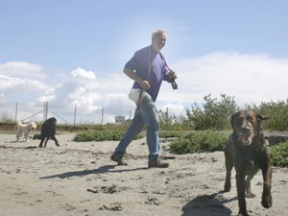Should creosote be capped or extracted? Local, federal officials are seeking direction.The mess was acknowledged long ago. At issue now is whether to remove the remnants or sweep them under the rug.
The answer remains uncertain after politicians, planners, and tribal and environmental agency leaders discussed future treatment options for the Wyckoff Superfund site in a closed-door meeting at City Hall Friday.
“We’re not picking sides,” said Jim Pendowski, who is managing cleanup on behalf of the state Department of Ecology.
Instead, Pendowski and others said, Friday’s meeting – from which the press was barred – was a forum to explore options for cleaning up the site, located on the southeast shore of Eagle Harbor.
Still, if sides can be defined, they could be organized based on information gathered at a post-meeting press conference Friday.
DOE, along with local legislators, the city and the Suquamish Tribe, favor removing from the ground creosote and other contaminants left over from a former wood treatment plant.
Standing opposite is the U.S. Environmental Protection Agency, which for now favors capping the site.
No timeline was set and no decisions made at Friday’s meeting, which has been in the works for months and was attended by several political leaders, including Congressman Jay Inslee, state Sen. Phil Rockefeller and state Rep. Christine Rolfes, as well as the EPA’s national director of Superfund Remediation and Technology Innovation, Jim Woolford, who came to Bainbridge from Washington, D.C. to attend.
The timing of the meeting roughly corresponds with an upcoming EPA review of the site, which was purchased by the city last year.
Whether that review heralds a fast-approaching decision on the EPA’s clean-up remedy is uncertain, but knowing the agency is leaning toward a cap was enough to prompt stakeholders to initiate a dialogue.
Meanwhile, along with uncertainty linger an estimated 1 million gallons of creosote and other contaminants in the soil and groundwater at the 50-acre site, which was home to the Wyckoff wood treatment plant until its closure in 1988.
There, for nearly a century, the facility coated and shipped telephone poles, railroad ties and other wood products, before dumping leftover creosote on-site.
The creosote seeped into the ground and harbor, causing damage to nearby habitat and wildlife.
Some $120 million worth of cleanup – including both capping and extraction – has been completed since the EPA took over management of the federal Superfund site, a designation given to the country’s worst hazardous waste areas.
The agency may be nearing the end of its portion of the cleanup, and in the coming years will pass the torch to the state.
For now, plans are to cap 11-acres on the point, a solution that would cost about $35 million, based on EPA estimates.
Along with the cap, the EPA would buttress the existing sheet-pile wall and increase the number of wells at the site for long-term monitoring.
Conversely, extraction of contaminants would cost an additional $118 million on top of the $35 million cap, which would have to be completed regardless.
EPA officials say it isn’t possible to remove all of the contaminants, and thus it makes no difference how much is left beneath the cap.
“For a fish out in the harbor or (Puget) Sound it comes down to what benefit would they see from that mass reduction,” said EPA Project Manager Mary Jane Nearman. “We do not think there is a tangible risk reduction.”
Others had a different take.
“It’s not a good idea to keep all that in the ground,” said city long-range planner Libby Hudson, of the contaminants.
Creosote is a toxin that poses only a minimal risk to humans, but is damaging to marine ecosystems, according to the EPA.
The Wyckoff site poses no immediate health risks, the agency said, though work to restore the damaged environment is ongoing.
The city, state, local legislators and the tribe are concerned about what might happen if the cap or wall were to eventually fail, either over time or as a result of an earthquake.
Maintenance costs for the containment plan already would cost the state an estimated $600,000 per year, Hudson said.
The EPA would be responsible for cleanup in the case of a failure, but Hudson and others are worried there could be disagreement in the future over what actually constitutes a failure.
“We want to express our concerns about the impacts on traditional waters,” said Leonard Forsman, Chair of the Suquamish Tribe.
“We need to think about our ancestors and future generations and do the right thing today.”
Many at the meeting believe the right thing includes extraction.
Extraction was tested by the EPA on a one-acre portion of the site as part of a pilot project in 2002 and 2003.
Officials say some contaminants were extracted, but that current technologies would never completely rid the land of pollutants. Again, Hudson had a contrasting view.
“It didn’t fail,” Hudson said of the extraction. “It was very successful. It pulled all kinds of stuff out of the ground.”
Extraction proponents are hoping the meeting will prompt the EPA to reconsider its position before if decides on a cap. Of such a cap, Mayor Darlene Kordonowy had a less-than-optomistic prognostication.
“We know it’s going to fail,” she said, “so let’s take the time to look at all the other options.”



